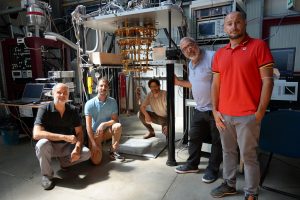 The first commissioning test of QUAX has been successfully performed at LNF.
The first commissioning test of QUAX has been successfully performed at LNF.
The first data taking, 120 minutes long, of the QUAX@LNF (QUaerere AXions) was conducted last week at the COLD laboratory. QUAX is an experiment devoted to the search of dark matter in the form of axions.
What are axions? About 25% of the Universe is made up of invisible matter that does not emit nor absorbs radiation, and it interacts only gravitationally: the dark matter. According to theoretical models, axions are hypothetical dark matter particles having a mass in the range between microelectronvolt and tens of millielectronvolt (billions times smaller than the electron’s mass) and, in the hypothesis that dark matter is entirely made up of axions of cosmological origin, these would be in a quantity of trillions particles per cubic centimeter. Again according to these theoretical models, axions interact with strong magnetic fields and they covert into photons of the same energy.
How does QUAX work? The QUAX experimental apparatus is composed by an antenna, which is a radiofrequency cavity cooled down at a temperature close to the absolute zero (in the order of milliKelvin) and surrounded by a very intense magnetic field (9 tesla). The presence of axions in the galaxy would cause a radiofrequency signal, detectable with amplifiers sensitive to a very low noise, that is why the cavity shoud be kept at temperatures close to the absolute zero. The cavity traps the photons generated by axions for a time sufficient to amplify the signal.
The first test in July In the test performed last week by the COLD team, the proper operation of the cavity and of the entire data acquisition system were checked. The results will provide information about the noise and the cavity that are useful to optimize the setup for the official QUAX@LNF’s data taking, scheduled in 2023.
The QUAX@LNF and QUAX@LNL collaboration The QUAX experiment is carried out in two INFN facilities: at the Frascati National Laboratory where the coupling of axions to photons is studied and at the Legnaro National Laboratory where the coupling of axions to electrons is also investigated. The collaboration includes researchers of Padua, Salerno and Trento INFN Units.
 INFN-LNF Laboratori Nazionali di Frascati
INFN-LNF Laboratori Nazionali di Frascati